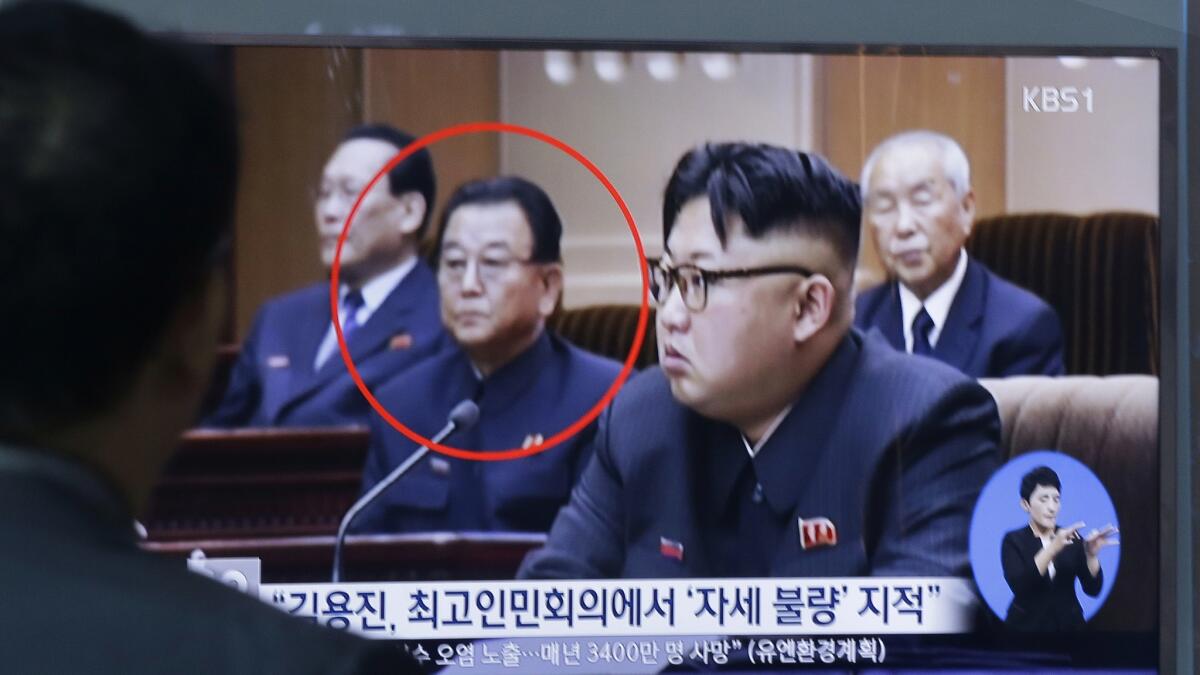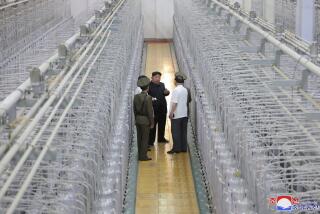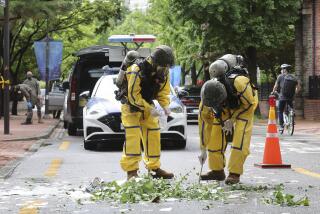North Korea just executed one of its highest-ranking officials for slouching at a meeting. Or did it?

Reporting from BEIJING â Last week, South Korean officials announced that North Korean leader Kim Jong Un had executed one senior official, reportedly for slouching at a political meeting, and banished two others to reeducation camps.
News of political violence in North Korea is nothing new â the communist country is known for its opacity and brutality. But for many dedicated North Korea-watchers, any developments within the countryâs highly secretive political class are cause for speculation.
Hereâs what experts are saying about the latest round of punishments:
How much do we know about this execution?
Not much. South Korean officials told reporters that North Korea executed Kim Yong Jin, a 63-year-old vice premier for education, in July by firing squad. Yet local media gave few details and attributed them to anonymous sources. South Koreaâs Unification Ministry spokesman Jeong Joon-hee confirmed the execution during a news conference Wednesday, according to CNN.
The briefing followed a report a day earlier by JoongAng Ilbo, a South Korean newspaper, claiming two senior North Korean officials â former Agricultural Minister Hwang Min and senior Education Ministry official Ri Yong Jin â had been executed with antiaircraft guns in August.
Whether the three executions were related remains open-ended.
So what does it take for a North Korean official to get executed?
Slumping, according to this weekâs announcement. Kim Yong Jin, the education official, âwas investigated by the Northâs intelligence agency due to his sitting posture shown at a key parliamentary meeting held in late June,â reported South Koreaâs Yonhap News Agency.
But very little about North Korean society is clear-cut or straightforward.
âThis current story is that he shrugged â that there was some kind of insubordination,â said John Delury, a North Korea expert and professor at Yonsei University in Seoul. âBut seemingly a very petty act of insubordination. So we assume from that, oh, Kim Jong Un is violent, and extremely insecure. If somebody doesnât stiffen their back when they walk in the room, he executes them.â
The North and South have remained in a state of conflict for six decades because the 1950-53 Korean War ended in an armistice. According to Delury, the two sides âare always badmouthing each other â thatâs par for the course.â
So whatâs actually going on?
We might never know. North Koreaâs state media rarely run anything about the âsupreme leaderâ other than strongman photos and ebullient praise.
What does South Korea make of all this?
South Korea points to killings and recent defections by high-level officials as signs of cracks in the government. The country has no shortage of North Korean sources, at both the highest and the grass-roots levels. Last month, a top-level diplomat in North Koreaâs embassy in Britain defected to the South, according to authorities in Seoul. In April, 13 employees of a North Korean-run restaurant in China fled to South Korea, seeking asylum.
But the government shows no obvious signs of rupture, and Kimâs father and grandfather had ruled for decades without facing any serious opposition.
Seoul hasnât always guessed correctly at its neighborâs maneuvers. A North Korean general labeled dead by South Korea popped up in May at a ruling party congress. This year, the Southâs intelligence officials failed to notice its rival had prepared for a fourth nuclear test.
âWe are hunting around for anything we can grasp on to that the place we hate is about to collapse,â said Robert Kelly, an associate professor of international relations at Pusan National University in South Korea. âBut weâll never really know.â
How much do we know about Kim Jong Unâs motives?
Again, very little. The last known execution of such a high-ranking official took place in 2013, when North Korea said Kim had executed the second in command â his uncle, Jang Song Taek. The Northâs state-run Korea Central News Agency released a 2,700-word statement calling Jang âdespicable human scumâ and accusing him of plotting to overthrow the government. Experts believe the new leader more likely wanted to eliminate older cadres who questioned his rule.
How long has this kind of thing been going on?
A long time. Since leaders proclaimed the Democratic Republic of Korea in 1948, the country has led a brutal existence, marked by intermittent purges.
Its first leader, Kim Il Sung, carried out bloody reeducation campaigns in his nearly half a century rule. Kim Jong Un succeeded his late father, Kim Jong Il, in 2011 and since has pushed out certain military and political elites in an effort to consolidate authority. A United Nations report in 2013 called Kim Jong Unâs public executions âone of the dreadful toolsâ used to rule by fear.
Why would North Korea use antiaircraft guns to execute officials?
We canât be too sure that it did.
âAnytime thereâs an execution now, youâll see the claim somewhere that they were killed with antiaircraft guns â itâs like a meme out there,â Delury said. âNorth Korea is a violent place. But I donât think itâs the kind of place where you get blown up with an antiaircraft gun because you shrugged at a meeting.â
Meyers is a special correspondent.
More to Read
Sign up for Essential California
The most important California stories and recommendations in your inbox every morning.
You may occasionally receive promotional content from the Los Angeles Times.










